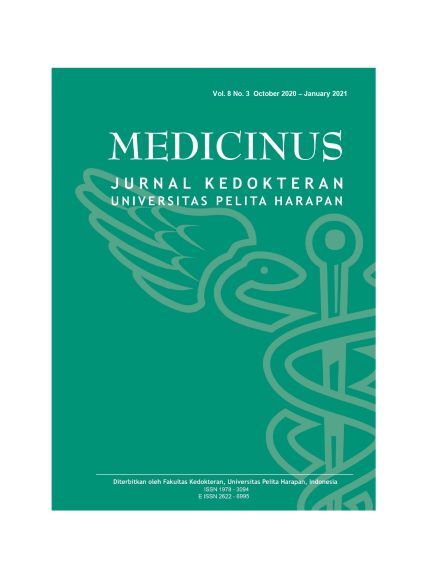Abdominal Wound Dehiscence: A Review of Risk Factors, Prevention and Management in Obstetrics and Gynecology Practice
DOI:
https://doi.org/10.19166/med.v8i3.3767Keywords:
Abdominal Wound Dehiscence, Clinical Review, Risk Predictors, ManagementAbstract
Abdominal wound dehiscence (AWD) is considered as a severe postoperative complication in which there is a partial or complete disruption of an abdominal wound closure with or without protrusion and evisceration. The incidence and mortality rate varies in different health centers. Risk factors are classified into three groups, which includes: pre-operative, intra-operative, and post-operative. The management of Burst Abdomen or Wound Dehiscence is diverse from conservative treatment to surgical treatment.
References
- Kapoor K, Hassan M. A clinical study of abdominal wound dehiscence with emphasis on surgical management in Bangalore medical college and research institute, Karnataka, India; 2016. https://doi.org/10.18203/2349-2902.isj20164078
- Mahmoud N, Kulaylat MD, Dayton MT. Surgical complications. Sabiston text book of surgery 19th edn; 2012:283-284. https://doi.org/10.1016/B978-1-4377-1560-6.00013-5
- Ningrum TP, Mediani HS, Isabella C. Factors correlating of wound dehiscence in patients after laparatomy at Dr Hasan Sadikin General Hospital Bandung. 2017;5(2);172-83.
- Vardhini KV, Kishan D. Incidence and risk factors influencing morbidity and mortality in cases of burst abdomen after emergency and elective midline laparotomies. International Surgery Journal. 2018;5(11):3471. https://doi.org/10.18203/2349-2902.isj20184611
- Muhar AM, Lutfi F, Sirait L. Risk factors affecting the difference of surgery's wound after emergency laparotomy in H. Adam Malik Hospital Medan-Indonesia. Bali Medical Journal. 2017;6(1):223-6. https://doi.org/10.15562/bmj.v6i1.559
- Naeem M, Khattak IA, Samad A, Waheed R. Burst abdomen: A common surgical problem. Journal of Medical Sciences (Peshawar). 2017;25(2):213-7.
- NK, Shekhar S. Study of burst abdomen: it's causes and management. International Surgery Journal. 2018;5(3):1035.
https://doi.org/10.18203/2349-2902.isj20180826 - de Beaux AC. Abdominal wall closure. British Journal of Surgery. 2019;106(3):163-4.
https://doi.org/10.1002/bjs.11081 - Saad AR. Risk Factors of Abdominal Wound Dehiscence: Evaluation and Outcome. Al-Nahrain College of Medicine. 2019.
- Burger J, Riet M, Jeekel J. Abdominal Incisions: Techniques and Postoperative Complications. Scandinavian Journal of Surgery. 2002;91:315-32.
https://doi.org/10.1177/145749690209100401 - Kingsbury B, Rathore S, Chelliah H, Londhe V, Benjamin SJ, Mathews J. Risk factors for peripartum wound dehiscence. Journal of Clinical and Diagnostic Research. 2018;12(11):11-4. https://doi.org/10.7860/JCDR/2018/37763.12232
- Podder AR, Jyothi GS. Burst Abdomen: A Preventable Complication in Gynecological Oncology. Indian Journal of Gynecologic Oncology. 2016;14(4):1-9.
https://doi.org/10.1007/s40944-016-0087-8 - Bartlett D, Kingsnorth A. Abdominal Surgery: Abdominal wound dehiscence and incisional hernia. 27th ed. Elsevier; 2009. https://doi.org/10.1016/j.mpsur.2009.05.001
- Falola RA, Tilt A, Carroll AM, Kim MJ, Bowles-Johnson G, Attinger CE, et al. Management of Abdominal Wound Dehiscence Following Cesarean Section: The Case for Debridement and Immediate Primary Re-Closure. ClinSurg. 2018; 3: 1881.
Downloads
Published
How to Cite
Issue
Section
License
Copyright (c) 2021 Gezta Nasafir Hermawan, Jacobus Jeno Wibisono, Lidya F Nembo

This work is licensed under a Creative Commons Attribution-ShareAlike 4.0 International License.
Authors who publish with this journal agree to the following terms:
1) Authors retain copyright and grant the journal right of first publication with the work simultaneously licensed under a Creative Commons Attribution License (CC-BY-SA 4.0) that allows others to share the work with an acknowledgement of the work's authorship and initial publication in this journal.
2) Authors are able to enter into separate, additional contractual arrangements for the non-exclusive distribution of the journal's published version of the work (e.g., post it to an institutional repository or publish it in a book), with an acknowledgement of its initial publication in this journal.
3) Authors are permitted and encouraged to post their work online (e.g., in institutional repositories or on their website). The final published PDF should be used and bibliographic details that credit the publication in this journal should be included.





